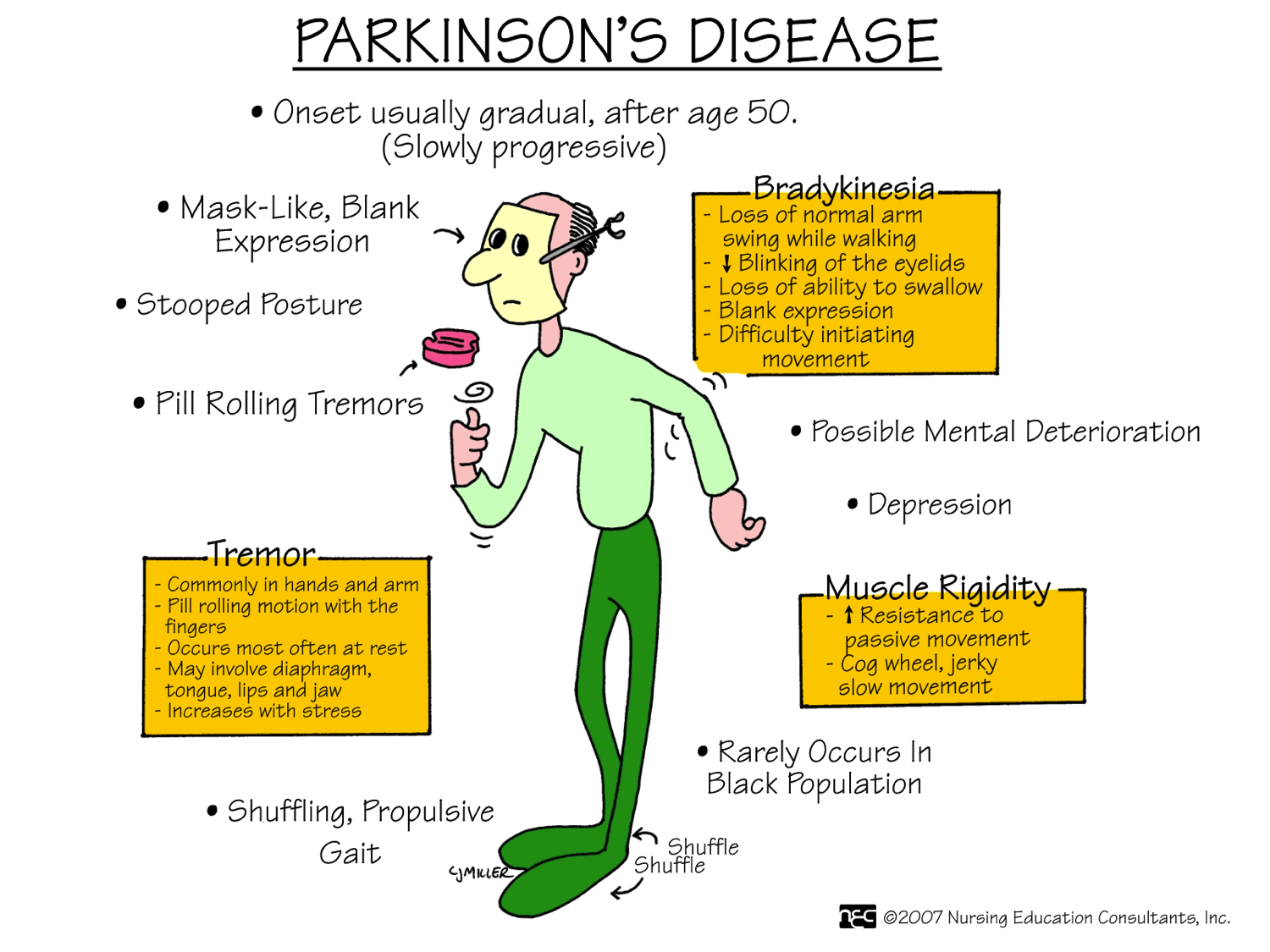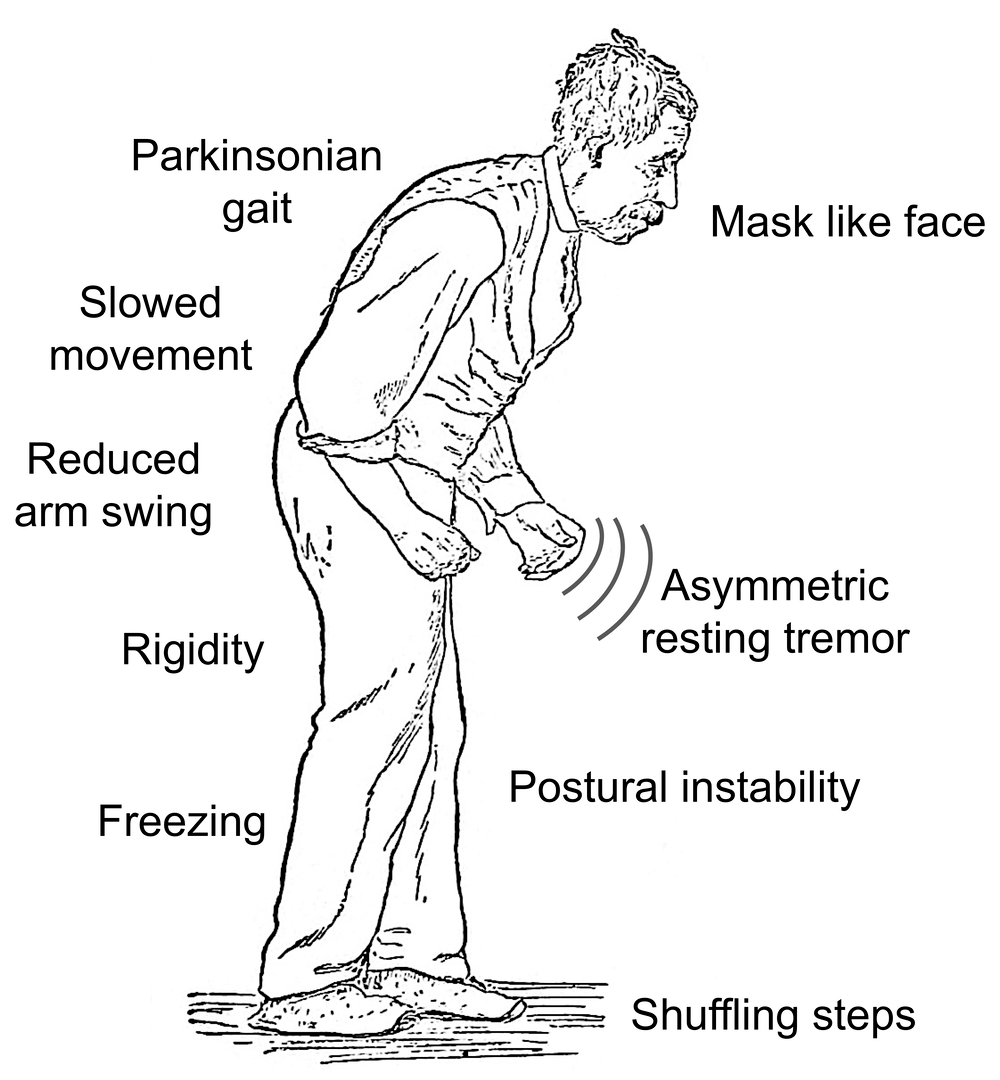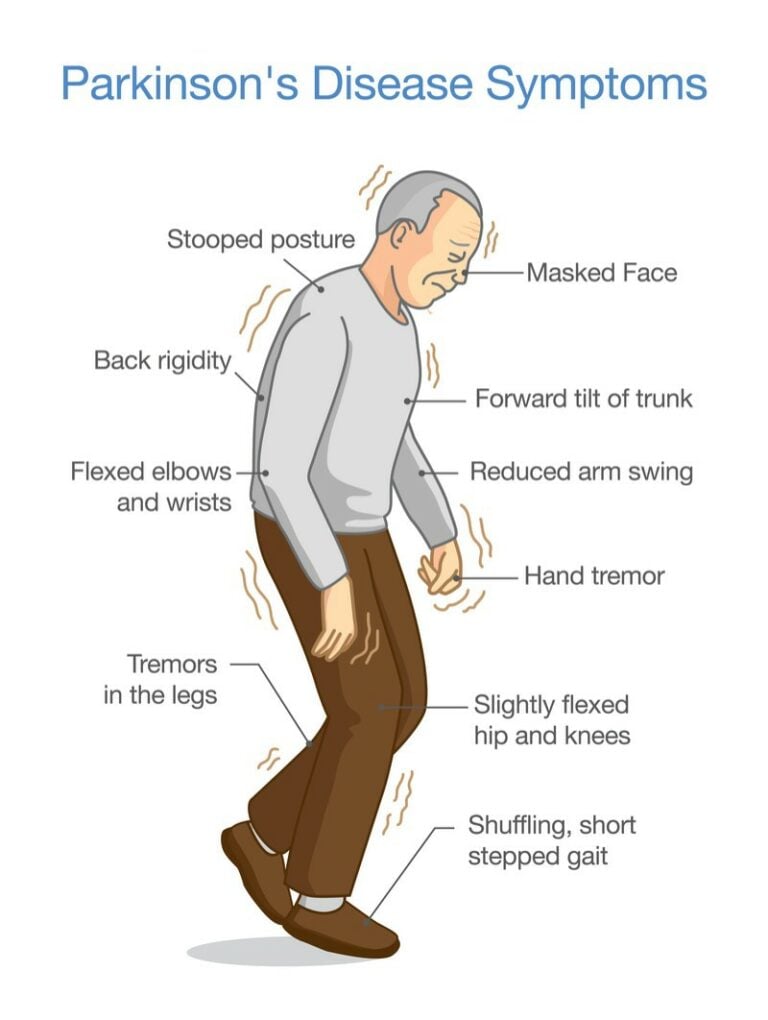Tremors In Parkinsons Disease: What They Are Types Of Tremors And More
Getting the trembling associated with Parkinsons under control can be a challenge, but treatments can help.
Nicole Rerk/Shutterstock
Tremors are a defining characteristic of Parkinsons disease, affecting about 8 out of 10 people with this movement disorder. Many people think the involuntary shaking motion is the main problem for patients. While it is certainly an irritating symptom that individuals want to get under control, other characteristics of the disease can be more debilitating.
Essential Tremor Is Not Parkinsons Disease
Essential tremor and Parkinsons disease are different conditions. Essential tremor is characterised by shaking when movement starts, which can continue or worsen during movement. The symptoms of Parkinsons disease include:
- involuntary tremor when you are not moving
- muscle stiffness
- slowness of movement
- freezing.
Parkinsons disease is caused by a lack of supply of the brain chemical dopamine, which is necessary for smooth and controlled muscular movement.
Symptoms Of Parkinsons Disease
Parkinson’s disease has four main symptoms:
- Tremor in hands, arms, legs, jaw, or head
- Stiffness of the limbs and trunk
- Slowness of movement
- Impaired balance and coordination, sometimes leading to falls
Other symptoms may include depression and other emotional changes difficulty swallowing, chewing, and speaking urinary problems or constipation skin problems and sleep disruptions.
Symptoms of Parkinsons and the rate of progression differ among individuals. Sometimes people dismiss early symptoms of Parkinson’s as the effects of normal aging. In most cases, there are no medical tests to definitively detect the disease, so it can be difficult to diagnose accurately.
Early symptoms of Parkinson’s disease are subtle and occur gradually. For example, affected people may feel mild tremors or have difficulty getting out of a chair. They may notice that they speak too softly, or that their handwriting is slow and looks cramped or small. Friends or family members may be the first to notice changes in someone with early Parkinson’s. They may see that the person’s face lacks expression and animation, or that the person does not move an arm or leg normally.
People with Parkinson’s often develop a parkinsonian gait that includes a tendency to lean forward, small quick steps as if hurrying forward, and reduced swinging of the arms. They also may have trouble initiating or continuing movement.
Read Also: Diseases Similar To Parkinsons
Stooping Or Hunched Posture
People who have Parkinsons disease may notice changes in their posture due to other symptoms of the disease, such as muscle rigidity.
People naturally stand so that their weight is evenly distributed over their feet. However, people who have Parkinsons disease may start bending forward, making them appear hunched or stooped over.
How Is Tremor Classified

Tremor can be classified into two main categories:
Resting tremor occurs when the muscle is relaxed, such as when the hands are resting on the lap. With this disorder, a persons hands, arms, or legs may shake even when they are at rest. Often, the tremor only affects the hand or fingers. This type of tremor is often seen in people with Parkinsons disease and is called a pillrolling tremor because the circular finger and hand movements resemble rolling of small objects or pills in the hand.
Action tremor occurs with the voluntary movement of a muscle. Most types of tremor are considered action tremor. There are several sub-classifications of action tremor, many of which overlap.
- Postural tremor occurs when a person maintains a position against gravity, such as holding the arms outstretched.
- Kinetic tremor is associated with any voluntary movement, such as moving the wrists up and down or closing and opening the eyes.
- Intention tremor is produced with purposeful movement toward a target, such as lifting a finger to touch the nose. Typically the tremor will become worse as an individual gets closer to their target.
- Task-specific tremor only appears when performing highly-skilled, goal-oriented tasks such as handwriting or speaking.
- Isometric tremor occurs during a voluntary muscle contraction that is not accompanied by any movement such as holding a heavy book or a dumbbell in the same position.
Recommended Reading: On Off Phenomenon
Diagnosis Of Parkinsons Disease
A number of disorders can cause symptoms similar to those of Parkinson’s disease. People with Parkinson’s-like symptoms that result from other causes are sometimes said to have parkinsonism. While these disorders initially may be misdiagnosed as Parkinson’s, certain medical tests, as well as response to drug treatment, may help to distinguish them from Parkinson’s. Since many other diseases have similar features but require different treatments, it is important to make an exact diagnosis as soon as possible.
There are currently no blood or laboratory tests to diagnose nongenetic cases of Parkinson’s disease. Diagnosis is based on a person’s medical history and a neurological examination. Improvement after initiating medication is another important hallmark of Parkinson’s disease.
Who Is Affected By Tremor
About 70% of people with Parkinsons experience a tremor at some point in the disease. Tremor appears to be slightly less common in younger people with PD, though it is still one of the most troublesome symptoms. People with resting tremor usually have a more slowly progressing course of illness than people without tremor.
Recommended Reading: Weighted Silverware
How Is Parkinsons Disease Diagnosed
Diagnosing Parkinsons disease is sometimes difficult, since early symptoms can mimic other disorders and there are no specific blood or other laboratory tests to diagnose the disease. Imaging tests, such as CT or MRI scans, may be used to rule out other disorders that cause similar symptoms.
To diagnose Parkinsons disease, you will be asked about your medical history and family history of neurologic disorders as well as your current symptoms, medications and possible exposure to toxins. Your doctor will look for signs of tremor and muscle rigidity, watch you walk, check your posture and coordination and look for slowness of movement.
If you think you may have Parkinsons disease, you should probably see a neurologist, preferably a movement disorders-trained neurologist. The treatment decisions made early in the illness can affect the long-term success of the treatment.
Other Tremors And How It Differs
A Parkinsonian tremor has a few distinct characteristics, though it may be easy to confuse with other types of tremors depending on the other symptoms a person shows. Doctors will look for and rule out other types of tremors to confirm their diagnosis.
The National Institute of Neurological Disorders and Stroke notes that some common tremors include:
Also Check: On And Off Phenomenon
Contact Our Information And Referral Helpline
The Parkinson Canada Information and Referral Helpline is a toll-free Canada-wide number for people living with Parkinsons, their caregivers and health care professionals. We provide free and confidential non-medical information and referral services. When you have questions or need assistance, our information and referral staff help connect you with resources and community programs and services that can help you. We provide help by phone or email, Monday to Friday, 9:00 a.m. 5:00 p.m. ET.
What Research Is Being Done
The mission of the National Institute of Neurological Disorders and Stroke is to seek fundamental knowledge about the brain and nervous system and to use that knowledge to reduce the burden of neurological disease. The NINDS is a component of the National Institutes of Health , the leading supporter of biomedical research in the world.
Researchers are working to better understand the underlying brain functions that cause tremor, identify the genetic factors that make individuals more susceptible to the disorder, and develop new and better treatment options.
Brain functioningIt can be difficult to distinguish between movement disorders such as Parkinson’s disease and essential tremor. These debilitating movement disorders have different prognoses and can respond very differently to available therapies. NINDS researchers are working to identify structural and functional changes in the brain using non-invasive neuroimaging techniques to develop sensitive and specific markers for each of these diseases and then track how they change as each disease progresses.
Other researchers are using functional magnetic resonance imaging technology to better understand normal and diseased brain circuit functions and associated motor behaviors. Scientists hope to design therapies that can restore normal brain circuit function in diseases such as Parkinson’s disease and tremor.
Medications and other treatment methods
You May Like: Parkinson’s Hallucinations Commercial
Managing Depression In Parkinsons Disease
People with Parkinsons, family members and caregivers may not always recognize the signs of depression and anxiety. If you are experiencing depression as a symptom of Parkinsons, it is important to know it can be treated.
Here are some suggestions:
- For information and support on living well with Parkinsons disease, contact our Information and Referral line.
- As much as possible, remain socially engaged and physically active. Resist the urge to isolate yourself.
- You may want to consult a psychologist and there are medications that help relieve depression in people with Parkinsons, including nortriptyline and citalopram .
Essential Tremor Vs Parkinsons Disease

Essential tremor and Parkinsons disease are both adult-onset tremor disorders that can be characterized by shaking that affects daily life. If you have one of these conditions, you may find it difficult to hold onto items, struggle to write normally, and notice your hands shaking uncontrollably. However, beyond that, there are many key differences.
If you believe you may suffer from one of these conditions, this guide can help you better understand the signs that you may have Parkinsons disease or essential tremor, how each is diagnosed, and what the treatment process entails. If you have questions about a certain aspect of these conditions, use the links below to navigate to its specific section:
Read Also: Parkinson Silverware
Is Parkinsons Disease Inherited
Scientists have discovered gene mutations that are associated with Parkinsons disease.
There is some belief that some cases of early-onset Parkinsons disease disease starting before age 50 may be inherited. Scientists identified a gene mutation in people with Parkinsons disease whose brains contain Lewy bodies, which are clumps of the protein alpha-synuclein. Scientists are trying to understand the function of this protein and its relationship to genetic mutations that are sometimes seen in Parkinsons disease and in people with a type of dementia called Lewy body dementia.
Several other gene mutations have been found to play a role in Parkinsons disease. Mutations in these genes cause abnormal cell functioning, which affects the nerve cells ability to release dopamine and causes nerve cell death. Researchers are still trying to discover what causes these genes to mutate in order to understand how gene mutations influence the development of Parkinsons disease.
Scientists think that about 10% to 15% of persons with Parkinsons disease may have a genetic mutation that predisposes them to development of the disease. There are also environmental factors involved that are not fully understood.
What Causes Parkinsons Disease
Parkinsons disease occurs when nerve cells in an area of the brain called the substantia nigra become impaired or die. These cells normally produce dopamine, a chemical that helps the cells of the brain communicate . When these nerve cells become impaired or die, they produce less dopamine. Dopamine is especially important for the operation of another area of the brain called the basal ganglia. This area of the brain is responsible for organizing the brains commands for body movement. The loss of dopamine causes the movement symptoms seen in people with Parkinsons disease.
People with Parkinsons disease also lose another neurotransmitter called norepinephrine. This chemical is needed for proper functioning of the sympathetic nervous system. This system controls some of the bodys autonomic functions such as digestion, heart rate, blood pressure and breathing. Loss of norepinephrine causes some of the non-movement-related symptoms of Parkinsons disease.
Scientists arent sure what causes the neurons that produce these neurotransmitter chemicals to die.
Read Also: Sam Waterston Parkinson’s
What Is The Outlook For Persons With Parkinsons Disease
Although there is no cure or absolute evidence of ways to prevent Parkinsons disease, scientists are working hard to learn more about the disease and find innovative ways to better manage it, prevent it from progressing and ultimately curing it.
Currently, you and your healthcare teams efforts are focused on medical management of your symptoms along with general health and lifestyle improvement recommendations . By identifying individual symptoms and adjusting the course of action based on changes in symptoms, most people with Parkinsons disease can live fulfilling lives.
The future is hopeful. Some of the research underway includes:
- Using stem cells to produce new neurons, which would produce dopamine.
- Producing a dopamine-producing enzyme that is delivered to a gene in the brain that controls movement.
- Using a naturally occurring human protein glial cell-line derived neurotrophic factor, GDNF to protect dopamine-releasing nerve cells.
Many other investigations are underway too. Much has been learned, much progress has been made and additional discoveries are likely to come.
Parkinsons Tremors Vs Essential Tremors
Because they can be similar to Parkinsons tremors, essential tremors are often confused as symptoms of the disease. Just as with Parkinsons, essential tremor can cause uncontrollable rhythmic shaking in different parts of the body.
Up to 10 million people are affected by this common nervous system disorder. While genetics and environment likely play a role in essential tremor, the cause is unknown, according to the U.S. National Library of Medicine.
Essential tremors in the hands or arms can be distinct from Parkinsons because they typically happen when the hands are in use.
The essential tremor can get really bad when youre using your limb when drinking or eating soup, for example, says Gilbert. The Parkinsons tremor is usually not as disabling whereas the essential tremor can be life-altering.
The shaking from an essential tremor typically improves when using both hands to bring a cup to the mouth but the same action can amplify the tremor in Parkinson’s, according to Gilbert.
Dr. Beck points out that an essential tremor may be faster than a Parkinsons tremor, which tends to be milder. A difference can often be seen in a persons handwriting. Those with essential tremor tend to have more unsteady and wavy writing, whereas Parkinsons patients are more apt to display micrographia, or abnormally small handwriting.
They have low amplitude movement so their writing gets smaller and smaller to a point where it can be barely legible, he says.
Also Check: Judy Woodruff Parkinson’s
How Are Parkinsons Tremors Treated
Tremor can be unpredictable. Some experts say itâs the toughest symptom to treat with medication. Your doctor may prescribe medication for your tremors:
- Levodopa/carbidopa combination medicines . This treatment is a type of medication called a dopamine agonist. Itâs usually the first treatment for Parkinsonâs.
Parkinsons Disease Is Recognized By Muscle Symptoms
Parkinsons is a neurodegenerative disease that occurs when certain nerves in the brain deteriorate. The nerves that die produce a neurotransmitter called dopamine, which controls muscle movement.
As the disease progresses and more nerves are damaged, declining levels of dopamine gradually lead to the muscle problems that are the hallmark of Parkinsons: tremors, muscle stiffness, and slow movement.
The tremors or shaking often begin on one side of your body in your fingers or hand. The uncontrollable shaking most often appears while your arm or hand are at rest. You may also notice facial tremors in your chin.
Stiffness when you walk is another one of the earliest motor signs of Parkinsons. You may notice stiffness that doesnt get better as you move. Shuffling your feet and not swinging your arms like you normally would while walking are also two red flags of Parkinsons.
These motor symptoms define Parkinsons, but by the time they appear, 60-80% of the dopamine-producing neurons have degenerated. The earliest signs of Parkinsons occur many years before tremors appear.
Also Check: Cleveland Clinic Parkinson’s Bicycle Study 2017
What Treatments Are Available For Tremors
Of all Parkinsons disease symptoms, the effect of drug treatments on tremors are the most unpredictable.When starting Parkinsons medicine treatments, you and your family should not judge their effectiveness by decreased tremors, but the simplification of daily tasks.Some medication, such as anticholinergics and propranolol, can be specifically used to treat tremors. However, they are not recommended for the elderly.When tremors become too overwhelming, deep brain stimulation can be considered. This is the most effective and reliable treatment available for tremors.Some medications can make your tremors worse. Discuss this with your neurologist.
Tremor In Other Conditions

While tremor is a common symptom of Parkinsons, it can also be a symptom of other conditions, most notably essential tremor. The main difference between Parkinsons tremor and most other types of tremor is that in Parkinsons resting tremor is most common. Other conditions are usually characterized by action tremor, which tends to lessen at rest and increase when youre doing something, like trying to make a phone call or take a drink.
Tremors of the head and voice are also common in essential tremor but rare in Parkinsons.
You May Like: Parkinson’s Double Vision
Treatments For Essential Tremor
According to Harvard.edu, there are several actions that can be taken to help manage your essential tremor and minimize how they impact your daily life. First, lets cover treatment options:
As each patient is different, you and your doctor will need to decide what the best course of action is for you. You must weigh the pros and cons of each treatment option based on your lifestyle and how you think theyll impact your quality of life.